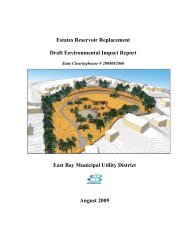You also want an ePaper? Increase the reach of your titles
YUMPU automatically turns print PDFs into web optimized ePapers that Google loves.
Table 7Typical Range of <strong>Noise</strong> Levels at 50 Feet from Construction Sites(dBA L eq )IndustrialParking Garage,ReligiousAmusement &Recreations,Store, ServicePublic WorksRoads &Highways,Sewers, <strong>and</strong>TrenchesOffice Building,Hotel, Hospital,DomesticHousingSchool, PublicWorksStationI II I II I II I II83 83 84 84 84 83 84 84GroundClearingExcavation 88 75 89 79 89 71 88 78Foundations 81 81 78 78 77 77 88 88Erection 81 65 87 75 84 72 79 78Finishing 88 72 89 75 89 74 84 84I - All pertinent equipment present at site.II - Minimum required equipment present at site.Source: United States Environmental Protection Agency, 1973, Legal Compilation on <strong>Noise</strong>, Vol. 1, p. 2-104.During construction activities, maximum instantaneous noise levels would vary depending on thespecific pieces of equipment operating on-site. Large pieces of earth-moving equipment, such asexcavators or front-end loaders, generate maximum noise levels of 85 to 90 dBA at a 50-footdistance. These noise levels drop off at a rate of about 6 dBA per doubling of distance between thesource <strong>and</strong> receptor. Shielding provided by barriers or structures can provide an additional 5 to 10dBA noise reduction at distant receivers.Representative sound levels for the most common types of construction equipment <strong>and</strong> usage factors,contained in FHWA’s Roadway Construction <strong>Noise</strong> Model, were used to calculate noise levelsrelated to proposed construction activities. The cumulative noise level would assume all pieces ofconstruction equipment were operating simultaneously at the site <strong>and</strong> represents a conservativeworst-case prediction of site construction noise levels during each construction phase. These data aresummarized in Table 8.The installation of pipelines (pavement removal, excavation, pipeline installation, compactingbackfill, <strong>and</strong> repaving the roadway) would result in average noise levels of approximately 86 dBAL eq at a distance of 50 feet. Maximum instantaneous noise levels during this phase would reach 89dBA L max at a distance of 50 feet assuming that a jack hammer would be required to remove theexisting pavement. The calculated hourly average noise level of 86 dBA L eq would exceed ambientnoise levels (plus 5 dBA) at the receivers by approximately 20 to 35 dBA L eq , which is a substantialincrease in noise. Pipeline installation would occur at a rate of approximately 60 to 80 linear feet perday. Therefore, construction noise levels would only exceed the significance criterion of 60 dBA L eqover a relatively short period of time (5 to 6 weeks). This would be considered a less than significantnoise impact recognizing the relatively short duration of project construction activities.14

















